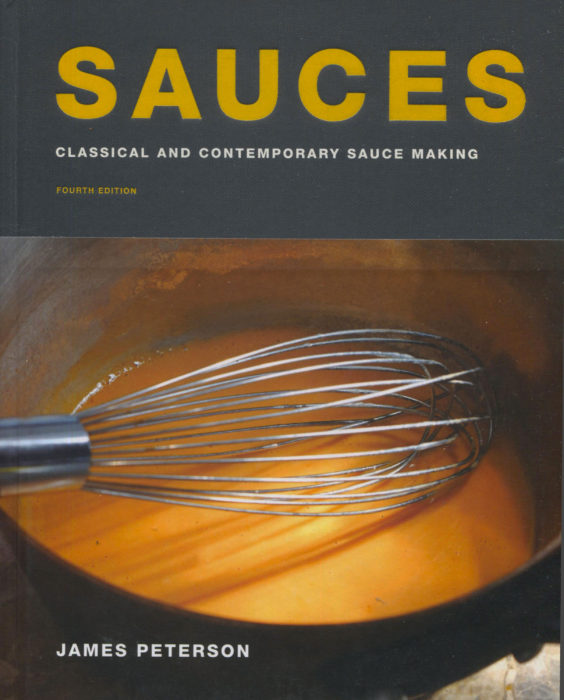
When a cookbook is 26 years old and is being reissued in a fourth edition, we need to pay attention. Is this book a “classic” or “essential” or both?
Sauces by James Peterson is classic, essential, and magnificent. This new edition is dramatically bigger: 666 pages up from 500. No, there is not a wave of new recipes, although there has been some modest adding and subtracting on that front. The reason for the change in page count is the happy addition of hundreds of color photographs to take your hand, and your eye, on the sauce-making journey.
Sauces are most important element of great cuisine, supply grace and texture. In America, we have not emphasized them to the extent you see in France or Italy or China. We have tended to cook “fast” and to be intimidated by “fancy” food. Yes, as Peterson so ably shows, sauces merely require some care, some time, and some passion. Reading this new edition, you’ll be guided to success whatever sauce you require.
The original sauce chapters are still here:
- Stocks, Glazes, and Essences
- White Sauces for Meat and Vegetables
- Brown Sauces
- Stock-Based and Nonintegral Fish sauces
- Integral Meat Sauces [integral := derived from the natural cooking juices of roasted and braised protein]
- Integral Fish and Shellfish Sauces
- Crustacean Sauces
- Jellies and Chauds-Froids
- Hot Emulsified Egg-Yolk Sauces
- Mayonnaise-Based Sauces
- Butter Sauces
- Salad Sauces, Vinaigrettes, Salsa and Relishes
- Purees and Puree-Thickened Sauces
- Dessert Sauces
But now, in response to contemporary cuisine style, we have new chapters:
- Foams
- Pasta Sauces
- Asian Sauces
The old chapters are intact, with modest changes to the recipe lists. The recipes themselves are the “same” in terms of ingredients, but the directions have sometimes been ungraded for clarity and to match the lively photographs.
The readability of Sauces has been improved. The page format is physically bigger: an inch higher and two inches wider. The paper quality is significantly better. The paper is whiter, the font thinner, the white space abounds. The result is a book easier on the eyes with pages “less crowded” and far more inviting.
Modernist techniques and ingredients have been woven into this edition, particularly in the new chapters. The new, and better, ways to make sauces are brilliantly evident on these pages. Peterson says that sauce technology has undergone a quantum leap in the past few years. Only Peterson has the skill, the experience, and the writing talent to bring this revolution to today’s audience. For example, there is a new table comparing all the thickening power key starches, fats, and hydrocolloids — those new darlings of the haute chemistry of modern cuisine.
Sauces is a book that can by your companion week in and week out for the rest of your culinary life. It’s a marriage you’ll embrace with happiness.
